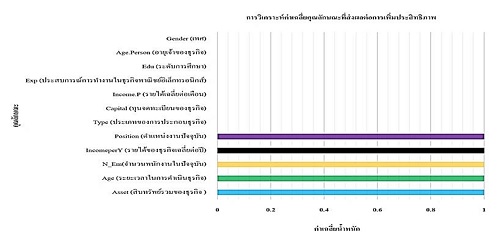A CLASSIFICATION MODEL FOR E-COMMERCE BUSINESS-BASED ON BASIC DATA ATTRIBUTES OF BUSINESS ENTREPRENEURSHIP TO OPTIMIZE THE PREDICTION OF E-COMMERCE BUSINESS TYPE IN THAILAND
DOI:
https://doi.org/10.14456/nrru-rdi.2023.44Keywords:
Classification model, E-commerce business, Optimize, PredictiveAbstract
The preparation for market change in e-commerce businesses to enable them to compete effectively and move towards a better direction has led to this research. The research objectives were: 1) to present the best classification model of e-commerce business-based on basic data attributes operations; 2) to analyze attributes that affect the optimization suitable for predictive e-commerce businesses; 3) to compare the effectiveness of the classification model with the feature analysis model using t-test and ANOVA statistics. The sample was 400 corporations engaged in e-commerce businesses in Thailand, selected using a content-valid questionnaire with a reliability index of 0.91, and questionnaire reliability scores from 0.72 to 0.98. Data was collected via postal mail, and data analysis employed data mining as a forecasting. The findings revealed that: 1) The support vector machine model is the best for predictive e-commerce business type in Thailand with an accuracy of 80.97% 2) The best model for the optimization of the classification is the decision tree model with an accuracy of 80.04% and 3) The features that influenced the effectiveness of prediction included total business assets, business operation period, total current employees, average annual business income, and current job positions Moreover, 4) the decision tree model and the support vector machine model demonstrated no significant difference in effectiveness and can be used interchangeably. The research indicates that the models are capable of accurate and precise predictions, and users can correctly rank the importance of data attributes, which is essential for the success of e-commerce business types.
References
Abdollahzadeh, B., & Gharehchopogh, F. S. (2022). A multi-objective optimization algorithm for feature selection problems. Engineering with Computers, 38(3), 1845-1863.
Bueno, S., & Gallego, M. D. (2021). eWOM in C2C platforms: Combining IAM and customer satisfaction to examine the impact on purchase intention. Journal of Theoretical and Applied Electronic Commerce Research, 16(5), 1612-1630.
Department of Business Development. (2021). Legal entity information and financial statements. Retrieved April 1, 2021, from https://datawarehouse.dbd.go.th/shearchJuristicInfo (In Thai)
Electronic Transactions Development Agency. (2022). Value of e-Commerce Survey in Thailand 2021. Retrieved February 2, 2022, from https://www.etda.or.th/th/Our-Service/Statistics-and-information.aspx (In Thai)
Guo, H., Liu, Y., Shi, X., & Chen, K. Z. (2021). The role of e-commerce in the urban food system under COVID-19: Lessons from China. China Agricultural Economic Review, 13(2), 436-455.
Han, J., Pei, J., & Tong, H. (2022). Data mining: concepts and techniques. N. P. : Morgan kaufmann.
Hayble-Gomes, E. (2023). The use of predictive modeling to identify relevant features for suspicious activity reporting. Journal of Money Laundering Control, 26(4), 806-830.
Huang, L., Huang, Y., Huang, R., Xie, G., & Cai, W. (2022). Factors influencing returning migrants’ entrepreneurship intentions for rural E-commerce: an empirical investigation in China. Sustainability, 14(6), 3682.
Mirkovic, M., Lolic, T., Stefanovic, D., Anderla, A., & Gracanin, D. (2022). Customer Churn Prediction in B2B Non-Contractual Business Settings Using Invoice Data. Applied Sciences, 12(10), 1-18.
Moonpen, U., Mungsing, S., & Banditwattanawong, T. (2020). Clustering Algorithm Optimization Model for Essential Attribute Analysis of Tour Package Forms Inbound Tourism Market in Thailand. The Journal of King Mongkut's University of Technology North, 30(4), 656-667. (In Thai)
Olson, D. L., & Delen, D. (2008). Advanced data mining techniques. New York : Springer.
Pinkum, S., & Kidrakarn, K. (2023). An Investigation into Improving Service Quality Distribution and Perceived Value in the Passenger Loyalty of Low-Cost Airlines in Thailand. Journal of Distribution Scicence (JDS), 21(4), 21-33.
RapidMiner. (2014). Rapid Miner 6.0 User Manual. Retrieved June, 14, 2021, from https://docs.rapidminer.com/download/RapidMiner-v6-user-manual.pdf
Taher, G. (2021). E-Commerce: Advantages and Limitations. International Journal of Academic Research in Accounting Finance and Management Sciences, 11(1), 153-165.
Theeramunkong, T. (2017). Introduction to Concepts and Techniques in Data Mining and Application to Text Mining Second Edition. Bangkok : Thammasat University Printing House. (In Thai)
Tirakanun, S. (2008). Social science research methods: guidelines for practice (7th ed.). Bangkok : Chulalongkorn University Printing House. (In Thai)
Wakil, K., Alyari, F., Ghasvari, M., Lesani, Z., & Rajabion, L. (2020). A new model for assessing the role of customer behavior history, product classification, and prices on the success of the recommender systems in e-commerce. Kybernetes, 49(5), 1325-1346.
Wang, Y., Jing, Z., & Lyu, J. (2022). Study on Sustainable Development Strategy of Rural E-Commerce in the Northeast of China—A Case Study of 11 Villages, 11 Towns and 4 Counties. Sustainability, 14(24), 1-21.
Wiwattananukul, B. (2021). Get to know B2C e-Commerce business: business model, payment model and how to track online market conditions. Retrieved May 29, 2023, from https://www.bot.or.th/content/dam/bot/documents/th/research-andpublications/research/stat-horizon-and-stat-in-focus/stat-horizon/B2C_eCommerce.pdf (In Thai)
Xuhua, H., Ocloo, C. E., Tsetse, E., Spio-Kwofie, A., & Musah Abdul-Aziz, I. (2019). The Moderating Role of Organizational Culture on Business to Business Electronic Commerce Adoption in Small and Medium Manufacturing Firms. International Journal of Management Sciences and Business Research, 8(3), 10-31.
Yamane, T. (1967). Statistics: An Introductory Analysis (2nd ed.). New York : Harper and Row.

Downloads
Published
How to Cite
Issue
Section
License

This work is licensed under a Creative Commons Attribution-NonCommercial-NoDerivatives 4.0 International License.




